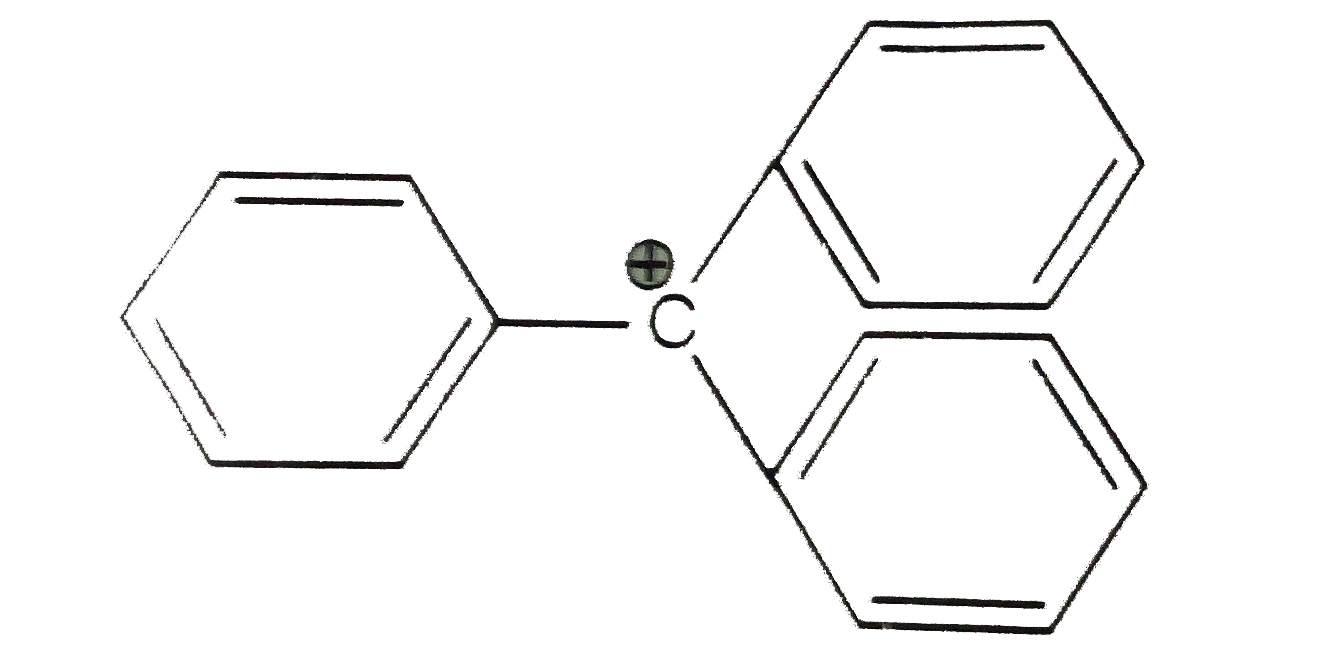The structure of triphenylmethyl cation is given below . This very stable and some of its salts can be stored for months . Explain the cause of high stability of this cation .

□ In triphenylmethyl cation, due to resonance the positve charge can move at both the o- and p-positions of each benzene ring .

[ Six more structures are possible due to resonance in other two benzene rings]
□ Totally nine resonance structures are possible for 3 benzene rings .
□∴ Triphenylmethyl cation is highly stable due to these nine resonance structure .
Topper's Solved these Questions
- BASIC CONCEPTS OF ORGANIC REACTIONS BOOK - SURA PUBLICATIONCHAPTER - BASIC CONCEPTS OF ORGANIC REACTIONS EXERCISE - ADDITIONAL QUESTIONS (LONG ANSWERS QUESTIONS)
13 Videos
- BASIC CONCEPTS OF CHEMISTRY AND CHEMICAL CALCULATIONSBOOK - SURA PUBLICATIONCHAPTER - BASIC CONCEPTS OF CHEMISTRY AND CHEMICAL CALCULATIONSEXERCISE - REDOX REACTION ACTIVITY
35 Videos
- CHEMICAL BONDINGBOOK - SURA PUBLICATIONCHAPTER - CHEMICAL BONDINGEXERCISE - Evaluate Yourself
16 Videos
Similar Questions
The structure of triphenylmethyl cation is given below. This is very stable and some of its salts can be stored for months. Explain the cause of high stability of this cation.

View Solution'Stability of carbocations depends upon the electron releasing inductive effect of groups adjacent to positively charged atom involvement of neighbouring groups in hyperconjugation and resonace''.
The structure of triphenylmethyl cation is given below. This is very stable and some of its salts can be stored for months. Explain the cause of high stability of this cation

View Solution
Knowledge Check
Under common reaction conditions, a carbocation rearranges to another carbocation of equal or greater stability. For example, a secondary carbocation will rearrange to a tertiary carbocation. It will not rearrange to a less stable primary carbocation. This generalization is not absolute, and because there is not a high energy barrier to the rearrangement of carbocations, rearrangement to a less stable cation can occur if it offers the chance to form a more stable product.
In which of the following cations rearrangement takes place?A B
B C
C D
D
Under common reaction conditions, a carbocation rearranges to another carbocation of equal or greater stability. For example, a secondary carbocation will rearrange to a tertiary carbocation. It will not rearrange to a less stable primary carbocation. This generalization is not absolute, and because there is not a high energy barrier to the rearrangement of carbocations, rearrangement to a less stable cation can occur if it offers the chance to form a more stable product.
In which of the following cations rearrangement takes place most rapidly?A BCH3−H∣C∣CH3−⊕CH2C
BCH3−H∣C∣CH3−⊕CH2C D
D
Under common reaction conditions, a carboncation rearranges to another carbocation of equal or greater stability. For example secondary carbocation will rearrange to a tertiary carbocation. It will not rearrange to a less stable primary carbocation. This generalization is not absolute, and because there is not is a high energy barrier to the rearrangement of carbocations, rearrangement to a less stable cation can occur if it offers the chance to forme a more stable product.
In the following cation , H/CH3 that is most likely to migarte to the positively charged carbon is :
H3C1−2H∣C∣OH−3⊕C∣H−4H∣C∣CH3−5CH3ACH3atC−4BHatC−4CCH3atC−2DHatC−2
"Stability of carbocations depends upon the electron releasing inductive effect of groups adjacent to positively charged carbon atom involvement of neighbouring groups in hyperconjugation and resonance."
The structure of triphenylmethyl cation is given below. This is very stable and some of its salts can be stored for months. Explain the cause of high stability of this cation.

View SolutionStructures and names of some hydrocarbons are given below. Explain why the names given in parenthesis are not correct :

View SolutionIn which of the following cations rearrangement takes place?
View SolutionUnder common reaction conditions, a carboncation rearranges to another carbocation of equal or greater stability. For example secondary carbocation will rearrange to a tertiary carbocation. It will not rearrange to a less stable primary carbocation. This generalization is not absolute, and because there is not is a high energy barrier to the rearrangement of carbocations, rearrangement to a less stable cation can occur if it offers the chance to forme a more stable product.
In which of the following cations rearrangement takes place most rapidly?
View SolutionUnder common reaction conditions, a carbocation rearranges to another carbocation of equal or greater stability. For example, a secondary carbocation will rearrange to a tertiary carbocation. It will not rearrange to a less stable primary carbocation. This generalization is not absolute, and because there is not a high energy barrier to the rearrangement of carbocations, rearrangement to a less stable cation can occur if it offers the chance to form a more stable product.
In the following cation, H/CH3 that is most likely to migrate to the positively charged carbon is :
H3C1−H∣2C∣OH−⊕3C∣H−H∣4C∣CH3−5CH3
View Solution
